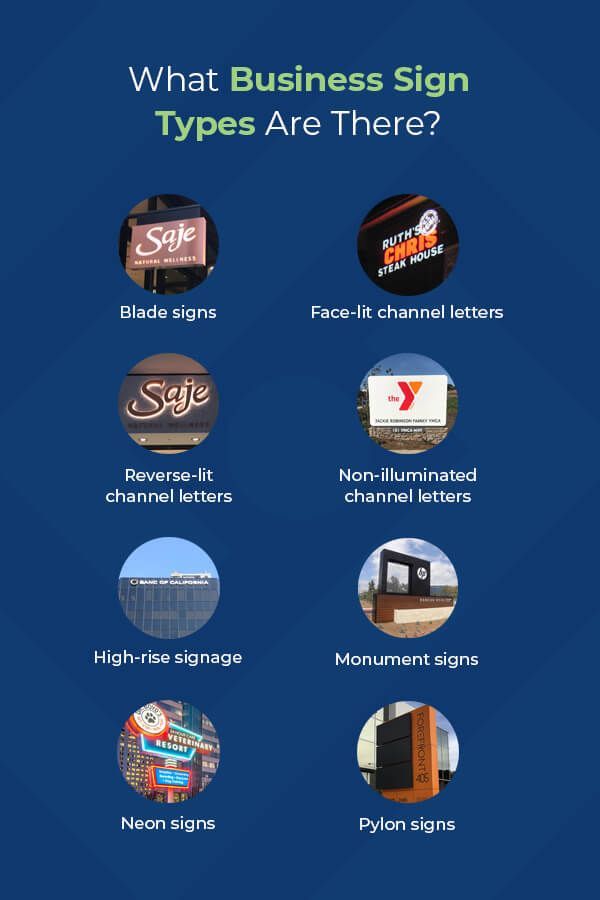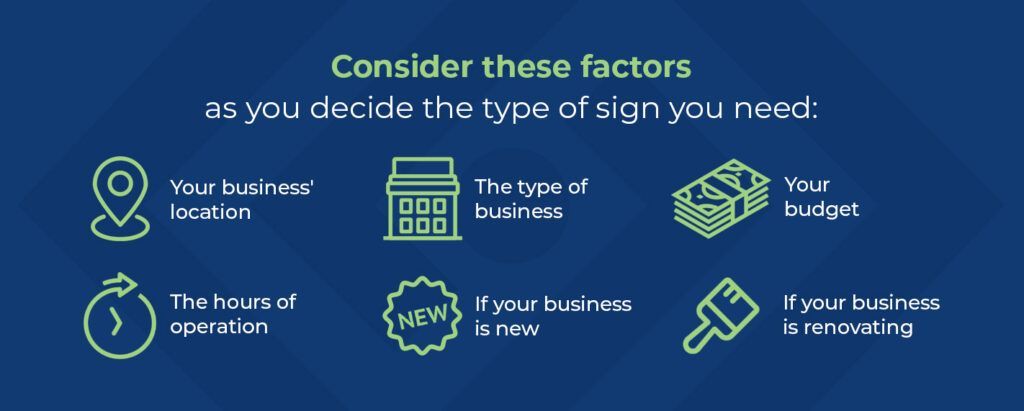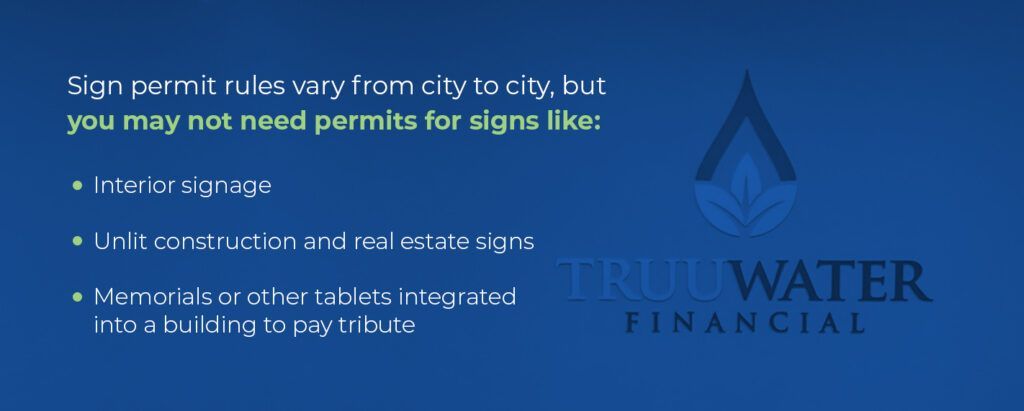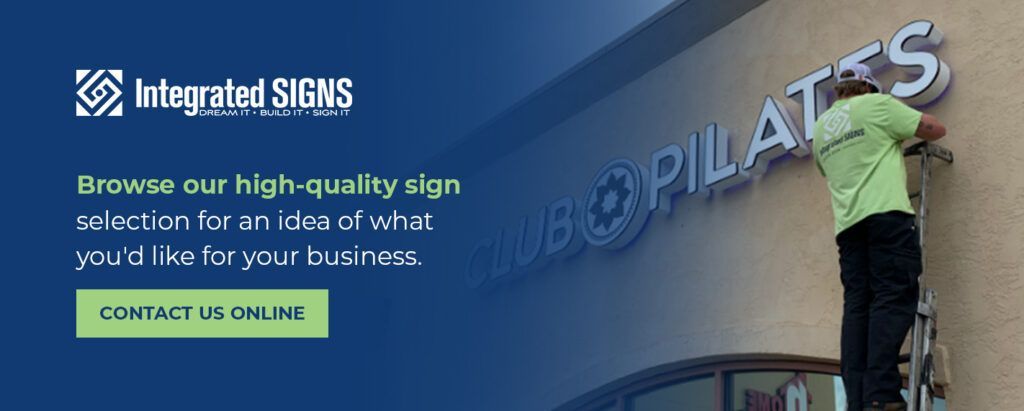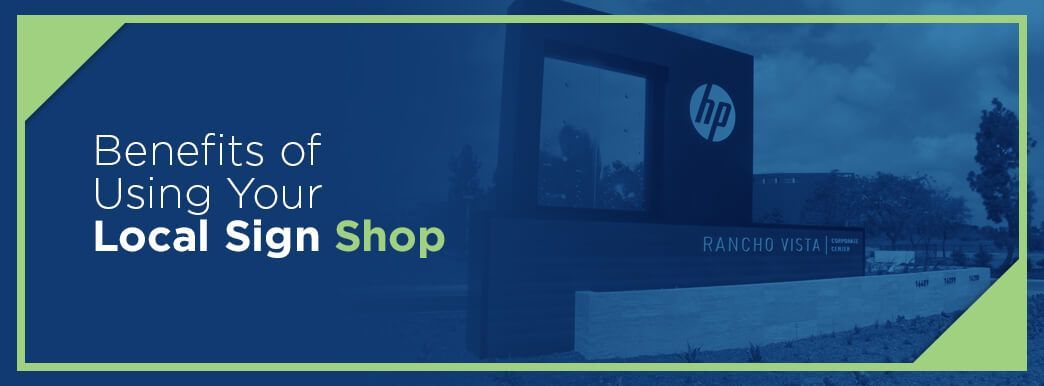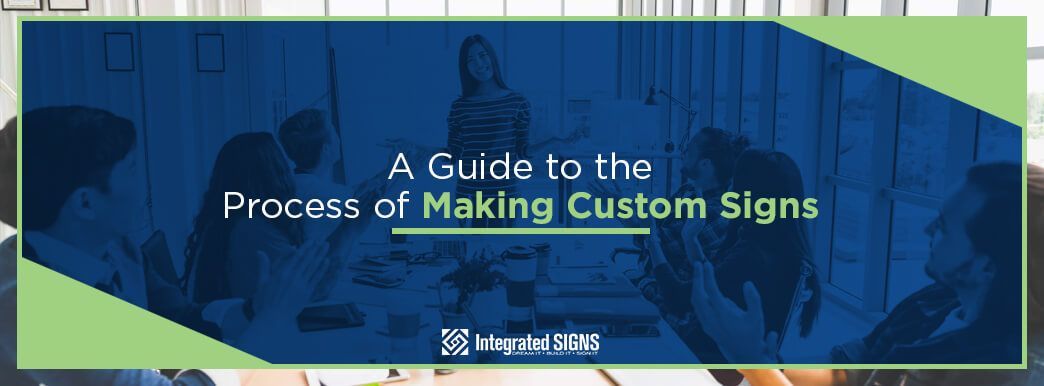- August 9, 2019
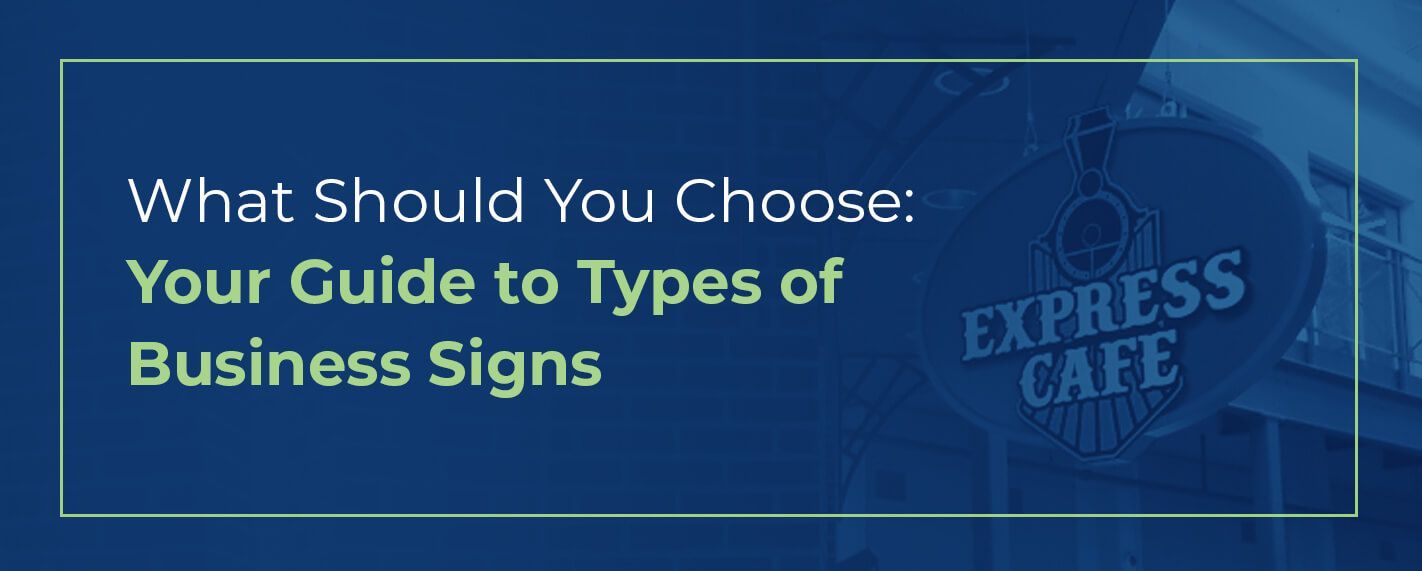
What Should You Choose: Your Guide to Types of Business Signs
When it comes to choosing custom business signs, there are many types to suit your needs. From outdoor to indoor, informative to decorative, your options are limitless. It may seem difficult to decide, but knowing your options gets you closer to a high-quality sign. Below you’ll find your guide to the many types of business signs out there. Read on to learn how to make the best selection for your brand.
What Business Sign Types Are There?
Before you choose your custom signs, you should know your options. There are plenty of types of storefront signs and indoor options to suit any need. Types of outdoor business signs include:
- Blade signs: Blade signs can help you draw the attention of passersby to your business. A blade sign projects from the front of a building, mounted by a pole and frame system or a decorative bracket. You will find this type of sign in lit and unlit varieties.
- Face-lit channel letters: Channel letters are individual characters and logos that sign companies install together to create your sign. Face-lit channel letters are among the most common outdoor lighted business signs. Their internal lighting creates illumination on the face of the letter, helping your sign stand out even at night. The characters come in a range of depths depending on your business sign designer. You may find sizes of two, three and five inches in depth.
- Reverse-lit channel letters: Also called halo-lit letters, this variety of channel letters is lit from behind. The light projects onto the wall behind it for a soft glow. Reverse-lit channel letters provide a great ambiance to your storefront.
- Non-illuminated channel letters: You can find channel letters in unlit options if you don’t need lighting on your sign. Non-illuminated channel letters feature the same style of individual characters and logos in a range of depths. Full-service sign companies produce these in aluminum or acrylic. They can then paint them to match your brand.
- High-rise signage: If your business is in a skyscraper, you can use high-rise signage to show individuals where to find you. Be sure to research your city’s building codes before choosing a high-rise sign for your business. These signs come with safety requirements and commonly use illuminated channel letters. Companies install them toward the top of buildings, so they must be eye-catching and secure.
- Monument signs: A monument sign draws from your building’s architecture. Businesses not visible from a main road use these signs. They typically include the address where customers will find the company.
- Neon signs: Get a vintage aesthetic with neon signs. Customized for you with molded glass tubing, neon signs provide a unique look. Speak with a business sign designer if you’re interested in neon to get an understanding of the in-depth process involved with these signs.
- Pylon signs: Pylon or pole signs appear on properties with many businesses. Industrial parks, malls and other centers use pylon signs to advertise the variety of businesses customers will find there. You can use a pylon sign if you own a center or if you’d like to promote your individual business.
An outdoor sign tells potential customers who you are and what you offer. It sets the tone for your company and tells individuals what to expect when they step inside. You can evoke the architecture of your building, integrate your logo and spruce up a storefront with exterior signage.
Once a customer comes inside, continue impressing them with your professional, high-quality signage. Check out these indoor business sign types:
- Code signage: The Americans with Disabilities Act (ADA) requires code signage for accessibility. Common rooms, restrooms and exits need conveniently located signs. Code signage must have legible fonts and colors along with raised lettering and braille. Work with a professional full-service sign company to get signs that meet regulations.
- Digital printing: Some business sign designers will create eye-catching designs for beautiful digital prints. You can use digital printing for decorative or informative needs, from welcome banners to feature walls. Modern technology allows sign companies to feature many colors and layers in a digital print. Get a detailed and professional look with these newer digital prints.
- Directories: You will usually find directories in the lobbies of buildings. Multi-tenant buildings can use a directory to point visitors in the right direction. If your business has many rooms or floors, use one of these signs to tell customers where to go.
- Environmental graphics: Find environmental graphics in digital print varieties or three-dimensional monuments. Your options in this category are limitless with different materials and designs. Choose color or black and white graphics to suit your brand, and bring your space to life with eye-catching environmental decor.
- Lobby and reception signage: Mirror your outdoor signs’ style with interior signage. The most common type of interior sign is lobby or reception signage. Like exterior channel letters, interior signage comes in lit and unlit options. Business sign designers can make this signage to match your business’ brand, just as they can with exterior channel letters.
Tell customers where to go once your outdoor sign draws them in with different types of indoor signage. Whether you use your indoor signs to provide information or decorate your space, you’re sure to impress visitors with your professional appearance. Some of the signs above make great interior or exterior options alike. In general, though, where these business sign types appear depends on their material.
What Types of Signage Material Are There?
A full-service sign company uses high-quality material to craft signs for your business. Some of those material options include:
- Acrylic
- Aluminum
- Carved wood
- Fabric
- Metal
- Neon
- Plastic
- PVC
- Vinyl
The types of signage materials available to you vary based on which business sign designer you use. No matter what they offer, a sign company will tell you what materials are best for your sign.
During your consultation, a designer may want to know where your sign is going and how long you plan on keeping it there. The weather in your area also influences a sign company’s suggestion for exterior signs. Temporary outdoor signs can use vinyl or other cheaper materials. Manufacturers use acrylic or aluminum in permanent outdoor sign types since those materials can withstand different climates.
Interior sign types can use any material. Designers will use your business’ brand and appearance to guide their material selection. Wood signs can provide a homey or rustic feel while neon offers a throwback aesthetic, but the design itself will largely dictate the tone of your sign.
The above materials combined with the types of business signs we’ve outlined provide a range of choices for your business. Before you order your signage, you should carefully consider what sort of signs you need.
What Types of Signs Do You Need?
The first step to getting new signs for your business is figuring out what you need. Consider these factors as you decide:
- Your business’ location: As we explained previously, the weather influences what type of materials your sign should feature. But your location has other impacts, as well. Businesses located in an industrial park or somewhere off a main road will find monument signs useful. If your business is multi-story, you need a directory or high-rise signage.
- The type of business: Your industry also influences what signage to get and what tone to use. We at ISA service industries from banking to education and small businesses. Any business with a physical location will benefit from a sign, but you have to consider what will be useful for you. A small business can use a blade sign on the storefront. A college may need a monument sign and directories for its buildings.
- Your budget: When you calculate your signage budget, there isn’t necessarily one standard price per sign. The size of your sign, the materials used and whether it is lit or unlit factor into the price. For example, a channel letter sign‘s cost will change depending on how many characters you need and how you choose to have the sign lit.
- The hours of operation: If your business closes around 5 p.m. and doesn’t see much foot traffic or other passersby at night, you may be able to choose an unlit sign. Businesses open past dark or on main roads that get people driving and walking by for most of the night may want to consider an illuminated sign. Lit signs are eye-catching and provide ambiance for business hours after sunset. If you aren’t open past then, you can choose to save money with an unlit sign.
- If your business is new: New businesses need most of the signs we outlined above. Order code signs that follow ADA guidelines for your restrooms, exits and common areas. Choose a style of exterior signage for your storefront and a similarly styled interior sign. Decorate with environmental graphics and digital printing.
- If your business is renovating: Renovating businesses won’t need as many signs as a new business, unless you’re going through a complete overhaul of your brand. Business revamping their storefront can start with exterior signage, like channel letters. A total brand change may involve newer interior signs along with outdoor ones.
A full-service sign company will guide your decisions if you provide them with some of the details above. They want to ensure that your signs work for you and your business, effectively bringing in and informing customers.
What Does Effective Signage Involve?
Your designer will help create effective signage for your business. If you aren’t sure what that involves, some of the factors that come into play include the following. Effective signage:
- Clearly advertises your business
- Tells potential customers where to find your business
- Is easy to read for anyone
The point of a sign is to inform potential customers about your business. You wouldn’t put up a sign for your company that doesn’t include its name because then customers wouldn’t know anything about your business. Similarly, you should incorporate a word or two that describes your business. A straightforward addition such as “bank,” “salon” or “restaurant” will tell potential customers what to expect when they step inside.
If a customer can’t easily access your business, an effective sign tells them the address or direction. Monument signs, pylon signs and directories provide locations to turn potential customers into visitors. You just have to make sure your signs are easy to read.
Legible fonts and colors along with tactile letters and braille make your signs accessible. Avoid dark-color fonts on dark-color backgrounds or light-on-light color combinations. Without high contrast, it will be challenging to read your sign up close, let alone far away. A professional business sign designer will help you create effective signage for your business following these and other guidelines. They may also help you ensure that your sign can go up without violating regulations and building codes.
How Do You Ensure Compliance With Local Regulations?
Getting your sign to meet local regulations is vital to certain types of storefront signs and other business signage. To install your sign safely, you will need to follow your local permit guidelines.
Acquiring a permit before a business sign designer manufactures your sign ensures that your product will be up to code. Sign permit rules vary from city to city, but you may not need permits for signs like:
- Interior signage
- Unlit construction and real estate signs
- Memorials or other tablets integrated into a building to pay tribute
What you can and cannot hang without a permit can change, so be sure to look into your local laws. Some full-service sign companies offer to complete the permit process for you, helping you submit any necessary fees, plans or applications. From there, you and the sign company can move forward with creating your signage.
What Common Mistakes Should You Avoid With Business Signs?
Once your sign idea meets local regulations, you should also ensure you aren’t making common mistakes with your sign. These mistakes include:
- Wrong location: If you put a blade sign on the wrong side of your building, no one will see it. If you install code signage in the wrong location, you violate ADA requirements. Your signs will provide information, but it isn’t helpful if your sign is in the wrong spot.
- Too big or too small: A directory doesn’t need to take up several walls, and your storefront sign should be big enough to see from a distance. Ordering a sign in the wrong size could lead to extra costs as you pay for a replacement. Avoid that by getting the size right the first time.
- Clashing or low-contrast colors: As we’ve explained before, an effective sign uses legible, high-contrast colors. You also want your sign to be visually appealing. Avoid choosing colors that clash within the sign or with your building and brand.
- Too much information: Your sign should have less than seven words. Any more than that, and you risk having no one read it. If no one reads your sign, no one will know about your business. Include the name of your business, your address and a word or two describing what you offer. Indoor environmental graphics can have more information on them, but keep it to a minimum with exterior signs.
- Too little information: Use more than one word to provide the right amount of information. The name of your business alone may not be enough to address what you do.
- Paying too little: It may be tempting to buy a cheaper sign through a printing company. You won’t get a quality sign that lasts if you pay less, though. The materials and design will look more professional with a business sign designer than a printing company, so spend your money wisely.
A full-service sign company will guide you through the sign selection process. Avoid these common mistakes with the help of a professional designer so you can invite customers into your business.
Where Should You Get Custom Business Signs?
Whether you’ve decided what types of business signs you need or you’d like some more guidance, Integrated Sign Associates can help. Browse our high-quality sign selection for an idea of what you’d like for your business. Contact us online or at (619) 579-2229 with any questions you have about what type of sign is best for your business.

